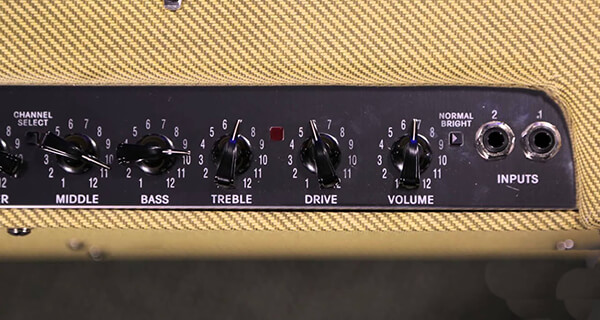Fender Blues Deluxe Vs Blues Jr [Difference & Which is Better]
Discovering the perfect Fender amplifier for your musical style and needs is essential. In this guide, we’ll examine the distinctions and parallels between the legendary Fender Blues Deluxe vs Blues Junior amplifiers. Whether you’re a seasoned performer or a casual player, this comparison will aid you in selecting the ideal Fender classic for your requirements.

# Table of Contents =>
Comparison Table:
| Features – | Fender Blues Deluxe | Fender Blues Junior |
|---|---|---|
| Amplifier Type | Combo | Combo |
| Power Output | 40 watts | 15 watts |
| Speaker Size | 1×12″ | 1×12″ or 1×10″ |
| Tubes | 3x12AX7, 2x6L6GC | 2x12AX7, 2xEL84 |
| Channels | 2 (Clean and Drive) | 1 (Clean) |
| Controls | Volume, Treble, Bass, Reverb, Master Volume | Volume, Treble, Bass, Reverb |
| Reverb | Spring Reverb | Spring Reverb |
| Effects Loop | Yes | No |
| Weight | Approximately 45 lbs (20.4 kg) | Approximately 31 lbs (14 kg) |
| Size (W x H x D) | 23.5″ x 18.75″ x 10.5″ (59.7 x 47.6 x 26.7 cm) | 18″ x 16″ x 9.18″ (45.7 x 40.6 x 23.3 cm) |
| Price Range (Approx.) | $$$ – $$$$ | $$ – $$$ |
| Suitable For | Gigging, Larger Venues | Home Practice, Small to Medium Venues |
| Tone Character | Warm, Clean, and Overdriven Tones | Crisp Clean Tones with Mild Overdrive |
| Notable Users | Joe Bonamassa, Kenny Wayne Shepherd | John Mayer, Derek Trucks |
Overview of Fender Blues Deluxe –
The Fender Blues Deluxe stands as a time-honored 40-watt all-tube amplifier, cherished by blues and rock guitarists over many years. Highlighting a 12-inch Eminence speaker and an adaptable control panel for precise tone sculpting, the Blues Deluxe has gained renown for its warm, pristine sound and its ability to deliver plenty of headroom. These qualities render it an excellent choice for both performing musicians and studio recording enthusiasts.
Key Features
- Power Output: 40 watts.
- Tubes: Three 12AX7 preamp tubes and two 6L6 power tubes.
- Speaker: 12-inch Eminence speaker.
- Controls: Volume, Treble, Middle, Bass, Reverb, Master Volume, and Presence controls.
- Effects Loop: Yes.
Tone –
The Blues Deluxe delivers a rich, warm clean tone that Fender amplifiers are renowned for. It excels at producing sparkling cleans and responds well to pedalboard effects, making it a versatile choice for various musical genres.
Performance –
The 40-watt power output provides enough headroom for larger venues and stages. The built-in reverb is lush and adds depth to your sound. The Blues Deluxe is suitable for players who want a versatile amp with a classic Fender sound.
Overview of Fender Blues Junior –
The Fender Blues Junior is a smaller, more compact amplifier compared to the Blues Deluxe. It’s a 15-watt tube amp with a single 12-inch speaker. Its portability and classic Fender tones make the Blues Junior a favored choice for smaller gigs, studio work, and home practice.
Key Features –
- Power Output: 15 watts.
- Tubes: Two 12AX7 preamp tubes and two EL84 power tubes.
- Speaker: 12-inch speaker (varies by model).
- Controls: Volume, Treble, Bass, Middle, Master, and Reverb controls.
- Effects Loop: No (but can be modded).
Tone –
The Blues Junior captures the classic Fender tone in a smaller package. Its sweet and dynamic clean tones are well-known, and many guitarists love it for breaking up earlier than the Blues Deluxe, providing a natural overdrive.
Performance –
With its lower wattage, the Blues Junior is ideal for smaller venues, home use, and recording. It’s a grab-and-go amp that’s easy to transport, making it a preferred choice for musicians on the move.
Differences Between Fender Blues Deluxe Vs Blues Junior:
a) Power Output:

With its 40-watt power output, the Blues Deluxe offers substantial headroom, making it well-suited for larger venues and situations where you need to project your sound with authority.
The Blues Junior, on the other hand, provides 15 watts of power, which, while less than the Blues Deluxe, offers a different advantage. Its lower wattage allows it to reach its sweet spot of natural overdrive at lower volume levels, making it an excellent choice for smaller gigs and studio work where cranking up the volume might not be practical.
b) Size and Portability:

The Blues Deluxe is larger and more substantial in size, making it a bulkier and less compact option. Due to its size and weight, the Blues Deluxe is less portable and may require more effort to transport, especially for gigging musicians on the go.
The Blues Junior is notably smaller and more compact, designed with portability in mind. Thanks to its compact size & reduced weight, the Blues Junior is highly portable & easy to transport. It’s an excellent choice for musicians who frequently move their gear or play in smaller venues.
c) Tone and Overdrive:
The Blues Deluxe is famous for delivering the clean and warm tone that Fender amplifiers are celebrated for. Its 40 watts of power provide ample headroom, allowing you to maintain crystal-clear clean tones even at higher volumes. While it can achieve overdrive when pushed, the Blues Deluxe typically breaks up at higher volumes. This means it’s more suited for those seeking a clean platform that can be driven with pedals for various levels of gain.
The Blues Junior captures the classic Fender tone in a smaller package. It’s beloved for its sweet and dynamic clean tones. Thanks to its lower wattage, it tends to break up earlier than the Blues Deluxe, giving it a natural and warm over driven sound, even at lower volume levels. If you’re looking for an amplifier that easily reaches over driven tones at manageable volumes, the Blues Junior excels in this regard. Players who appreciate the organic breakup that occurs when pushing the amp’s lower wattage favor it.
d) Effects Loop:
The Blues Deluxe comes equipped with an effects loop. This feature is valuable for guitarists who use a variety of pedals and effects processors, as it allows you to integrate these effects into your signal chain more efficiently. An effects loop can help maintain the amp’s clean tone when using time-based effects like reverb, delay, or modulation.
The Blues Junior does not come with a built-in effects loop as a standard feature. However, it’s worth noting that some guitarists choose to modify their Blues Junior amps to add an effects loop. This modification can be performed by a qualified technician if desired.
Which One Is Better for Performance?
Choosing between the Fender Blues Deluxe vs Blues Junior depends on your specific needs:
Blues Deluxe: If you’re a gigging musician playing larger venues and need ample headroom, the Blues Deluxe is the better choice. Its 40-watt power output and clean tones make it suitable for a wide range of musical styles.
Blues Junior: If you value portability, want that classic Fender tone, and play in smaller settings, the Blues Junior is a fantastic option. It’s also an excellent choice for home practice and studio recording, especially if you prefer natural tube overdrive.
Ultimately, both amplifiers offer that unmistakable Fender sound, and your choice should align with your playing style and performance needs. Consider your wattage requirements, portability concerns, and tonal preferences to make the right decision for your music.
In conclusion, whether you opt for the Blues Deluxe or Blues Junior, you’ll be acquiring a piece of Fender’s storied history and a reliable amplifier that can help you achieve the classic tones that have defined generations of guitar music. Happy playing!
FAQs –
Q. Why is the Fender Blues Junior so popular?
Answer: The Fender Blues Junior is popular because it offers excellent vintage Fender tone in a compact and portable package, making it ideal for gigging musicians and home players alike. Its simplicity, affordability, and great sound have made it a favorite among blues and rock guitarists.
Q. Is the Fender Blues Junior too loud for home use?
Answer: The Fender Blues Junior’s 15-watt output can be loud for home use, especially when cranked. However, it has a volume control that allows you to dial in lower volumes for quieter practice. Additionally, using an attenuator or an external volume pedal can further control the volume, making it suitable for home practice without disturbing neighbors.
Last Updated on October 13, 2023 by Perry Garner


